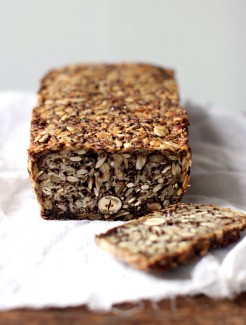The Life-Changing Loaf of Bread

It wasn’t until I went for lunch at a friend’s place a couple weeks ago that my life changed. When I walked into her apartment I could smell it. Something malty and definitely baked, toasty, nutty…when I rounded the corner to her kitchen, there it was. A very beautiful loaf of bread, pretty as a picture, studded with sunflower seeds, chia and almonds, golden around the corners and begging me to slice into it.
She served it with a number of spreads; pesto, lentil hummus, some veggie pate. It magically seemed to compliment everything I slathered across its speckled flesh. Moist, dense, chewy. Hints of sea salt here and there, nestled between the oats, around the corner from a golden flax seed. So beautiful and more than tasty, this was a revelation. “Please tell me this is good for me!” I begged her. She smiled.
You’re probably asking yourself how the heck this bread holds itself together without any flour. Nice observation, and the answer is psyllium seed husks.
Psyllium seed husks are one of nature’s most absorbent fibers, able to suck up over ten times their weight in water. For this reason, you’ll often find psyllium in over-the-counter laxatives, stool-bulking agents and colon cleansing kits; basically anything having to do with poo. I just came back from running a detox course in Lisbon where I got all the participants in-the-know about this amazing little supplement that also helps to reduce cholesterol levels, aid digestion and weight loss, and alleviate diarrhea and constipation.
Psyllium seed husks contain both soluble and insoluble fiber. The soluble fiber dissolves in water and soothes the digestive tract with its mucilaginous properties, while the insoluble fiber acts like a broom to sweep the colon free of toxins. Taken during a detox, juice cleanse, or fast, psyllium can greatly improve the body’s ability to eliminate impurities. But the good news is, you can take it anytime – many people find that a daily dose of a teaspoon or two in a glass of water really helps them get their bowels moving, (or slow them down if necessary).*
But what does this have to do with bread? Well, the idea here is to use psyllium to bind all these lovely ingredients together without resorting to flour. There have been some low-carb bread recipes floating around the ‘net as of late that take advantage of psyllium and I think it’s a great idea. Eat delicious bread, have good poops. I’m in!
Psyllium is available at health food stores and most pharmacies. It comes in two forms, the raw husks themselves, and powdered, which are just the husks that have been pulverized. It is easier to take the powdered form as it dissolves easier in water, but that is not important in the case of this bread – either type work just fine.
1 cup / 135g sunflower seeds
½ cup / 90g flax seeds
½ cup / 65g hazelnuts or almonds
1 ½ cups / 145g rolled oats
2 Tbsp. chia seeds
4 Tbsp. psyllium seed husks (3 Tbsp. if using psyllium husk powder)
1 tsp. fine grain sea salt (add ½ tsp. if using coarse salt)
1 Tbsp. maple syrup (for sugar-free diets, use a pinch of stevia)
3 Tbsp. melted coconut oil or ghee
1 ½ cups / 350ml water
1. In a flexible, silicon loaf pan combine all dry ingredients, stirring well. Whisk maple syrup, oil and water together in a measuring cup. Add this to the dry ingredients and mix very well until everything is completely soaked and dough becomes very thick (if the dough is too thick to stir, add one or two teaspoons of water until the dough is manageable). Smooth out the top with the back of a spoon. Let sit out on the counter for at least 2 hours, or all day or overnight. To ensure the dough is ready, it should retain its shape even when you pull the sides of the loaf pan away from it it.
2. Preheat oven to 350°F / 175°C.
3. Place loaf pan in the oven on the middle rack, and bake for 20 minutes. Remove bread from loaf pan, place it upside down directly on the rack and bake for another 30-40 minutes. Bread is done when it sounds hollow when tapped. Let cool completely before slicing (difficult, but important).
4. Store bread in a tightly sealed container for up to five days. Freezes well too – slice before freezing for quick and easy toast!
None Available.